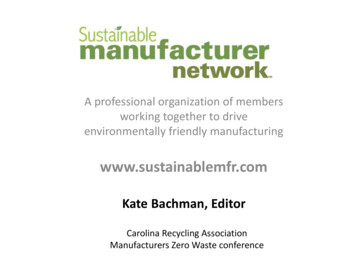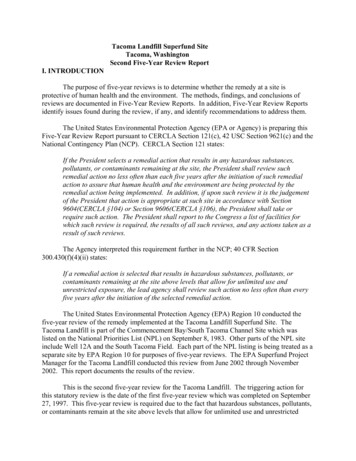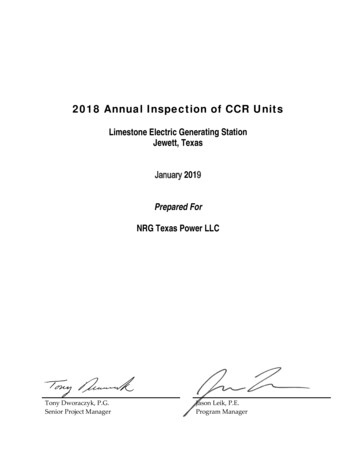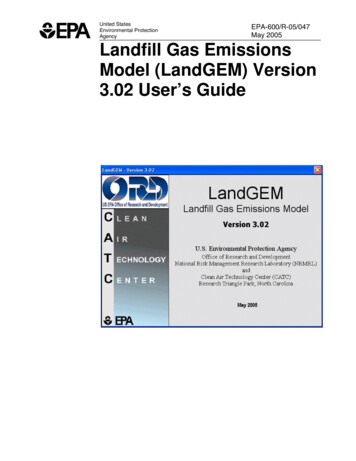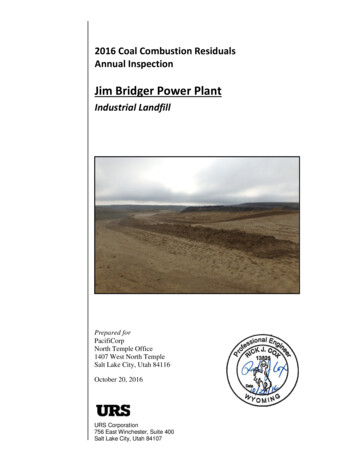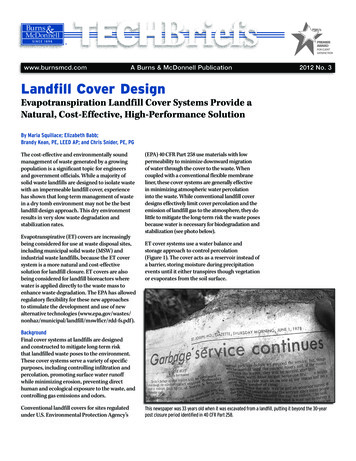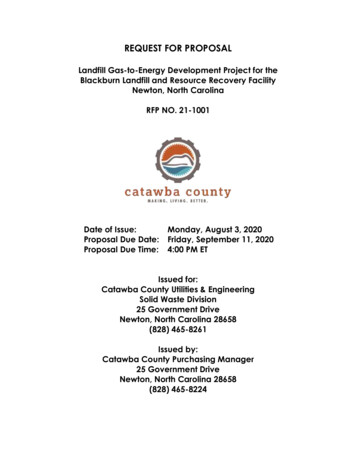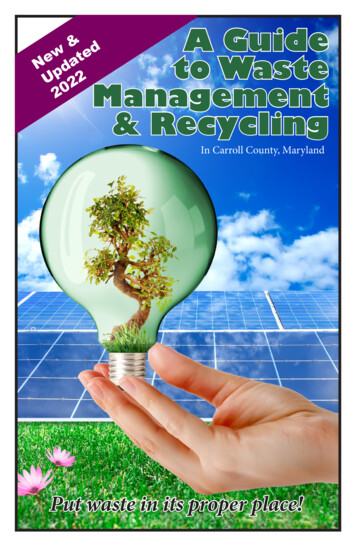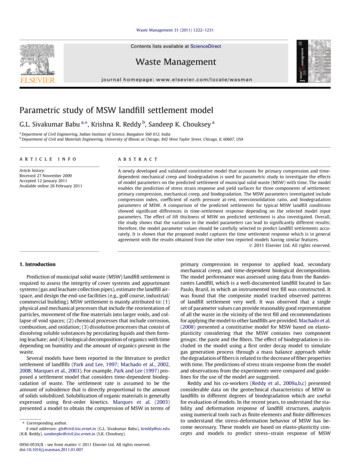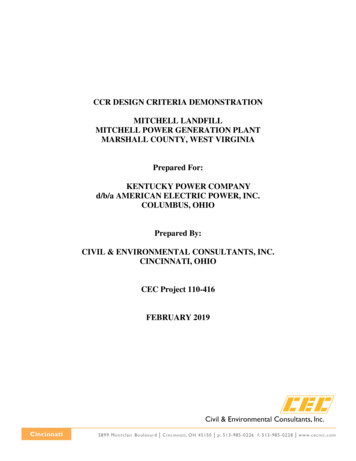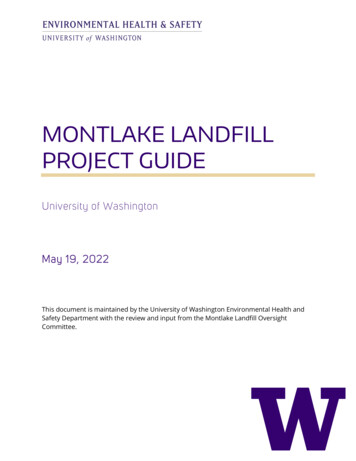
Transcription
MONTLAKE LANDFILLPROJECT GUIDEUniversity of WashingtonMay 19, 2022This document is maintained by the University of Washington Environmental Health andSafety Department with the review and input from the Montlake Landfill OversightCommittee.
TABLE OF CONTENTSI.Introduction .3History .3Oversight .3II.Project Planning .4III.Environmental Requirements and MLOC Guidelines . 5A.Landfill Settlement and Displacement . 5B.Grading .6C.Drainage .6D.Stockpiling .6E.Resurfacing Roads and Parking Areas . 6F.Methane Gas .7G.Stormwater Control . 8H.Critical Areas, Wetlands and Shorelines . 9I.Landfill Media Disposal (Cap Soil, Debris, Stormwater and Groundwater) . 9J.Asbestos-Containing Material .10K.Worker Safety .10L.Fencing .11M.Sports Fields .11N.Corrosion Protection .11O.Structure Foundations .11Figure 1 – Approximate Boundaries and 1000-foot Buffer Zone of the Montlake Landfill .13Table 1 - Montlake Landfill Water and Soil Analytical Requirements .14Montlake Landfill Project Guide www.ehs.washington.edu Revised 5/19/2022 Page 2 of 14
I.IntroductionThe Montlake Landfill, part of the University of Washington (UW) East Campus, is a uniqueenvironment containing the Union Bay Natural Area, shorelines, wetlands and a ripariancorridor. The area is currently used for vehicle parking, teaching and research, and birdwatching. Sports facilities, a golf driving range, and a helipad also occupy the site. Boundaries ofthe UW East Campus area are delineated in the UW Seattle Campus Master Plan, dated January2003. Changes to these boundaries are not anticipated.This Montlake Landfill Project Guide identifies key issues and regulations applicable to theMontlake Landfill and immediate vicinity. It presents guidelines for maintenance andconstruction activities on the landfill area. It is based on the 1993 East Campus MaintenancePlan and supplements the Union Bay Natural Area and Shoreline Management Guideline, 2010.In addition, it incorporates recommendations made by the Montlake Landfill OversightCommittee (MLOC) presented in the 1999 Montlake Landfill Information Summary.HistoryThe Montlake Landfill, also known as the Ravenna Landfill, was operated as a burn dump andeventually a landfill by the City of Seattle during the period approximately 1926 through 1966.Municipal solid waste, primarily consisting of residential wastes, was disposed in the landfill.Some limited amounts of industrial waste that could be considered hazardous were alsodisposed at this location.Figure 1 presents a map of the Montlake Landfill area. Although the exact limits of the MontlakeLandfill are not definitively known, available documentation suggests that the landfill isgenerally bounded by Montlake Boulevard NE to the west; NE 45th Street to the north; LaurelVillage and the Douglas Research Conservatory to the east; and Canal Road, the IntramuralActivities Building, and Union Bay to the south.In 1971, the landfill was closed according to the landfill standards in effect at that time, and wascapped with approximately two feet of clean soil. Landscaped areas received an additional sixinches of topsoil. Trenching, boring, and excavations activities at the landfill since closureindicates that the cap is less than two feet thick at some locations, and solid waste may belocated directly under grass or asphalt-covered locations. A protective 3-foot thick clean soil capis currently required by the UW.The landfill consists of varying depths of fill, refuse and peat and has therefore experienceddrainage problems due to differential settlement. Clean fill has been added and minor repairwork done on the roads, parking areas and sports fields to maintain site usability.Methane gas is produced in varying concentrations both from the large underlying peat depositand from decomposing landfill debris.OversightIn 1999, UW Executive Vice President Weldon Ihrig established the Montlake Landfill OversightCommittee (MLOC) as an advisory group to help ensure that landfill-related issues are notoverlooked, and that appropriate use and protection of the site is ensured in perpetuity. MLOCoversight is limited to projects on UW properties. The MLOC meets each calendar quarter toMontlake Landfill Project Guide www.ehs.washington.edu Revised 5/19/2022 Page 3 of 14
assess current and proposed activities in and near the landfill area, and to evaluate newinformation and regulations associated with the landfill.In 2000, the departments of Public Health - Seattle & King County (Public Health) andWashington State Department of Ecology (Ecology) conducted a site hazard assessment of theMontlake Landfill. While their assessment did not allow the landfill to be removed fromEcology’s Hazardous Sites List, results indicated that if the Montlake Landfill were leftundisturbed, the risk of adverse impacts to human health and the environment would berelatively low. Remedial cleanup of the landfill area was not recommended. However, somemaintenance, renovation, and construction activities have the potential to disturb the MontlakeLandfill cap and debris. Therefore, EH&S must be contacted at 206.616.0585 prior to anyactivities having the potential to penetrate the landfill cap and disturb landfill debris.Construction and maintenance activities on the Montlake Landfill must comply with allapplicable federal, state, and local laws, regulations, codes, and ordinances.II.Project PlanningConstruction and maintenance projects on the Montlake Landfill are generally expected to havelonger timelines and cost more to meet additional structural and environmental requirements.The UW Project Manager must plan ahead as much as possible to shorten timelines andminimize costs.Permitting and approvals within or adjacent to the Montlake Landfill boundary are difficult toobtain and a lot of preplanning information is required. Wetlands, shorelines, critical areas,methane, the landfill itself all create regulatory reviews by the City, State and Corps ofEngineers. Resource agencies like Ecology and Fish and Wildlife want to work with theUniversity as partners and provide important resources and experience to guide projects in thisarea of campus. Project managers need to include adequate time in project schedules forpermitting. Resource agencies (both city, state and federal) carefully monitor the University’sactivities and projects in this area of campus. Regulations are often difficult to interpret andsometimes seem to be conflicting – it is part of the project planning process to carefullydetermine what requirements apply to specific projects and often early contact with theseexperts is required.It is also important to include University Process Partners, early in the project planning process.University experts in CPO, EH&S and Facilities Services are highly respected by the resourceagencies and can provide critical advice as projects are planned in this part of campus.Schedules must allow for the coordination with University, City, State and Federal agencies.While the University has information, surprises and the unknown often occur. These can createadditional project costs and time delays. For example, when the soccer field was re-graded,asphalt chunks from a demolished road were buried in the 3’ cap of dirt fill, not the 2 feet ofclay capping the landfill. The source of the asphalt chunks was never determined however itwas thought to be from roads demolished during the construction of I-5. The end result wasthat this created extra costs for additional grading, infill and haul-off. New findings such as thisduring a project may result in the need to coordinate with resource agencies as well.Montlake Landfill Project Guide www.ehs.washington.edu Revised 5/19/2022 Page 4 of 14
Project Managers and EH&S staff must coordinate closely whenever construction or excavationoccurs on the landfill since landfill debris and cap soil within 3 feet of landfill debris cannot bereburied onsite. EH&S reviews activities having the potential to penetrate the landfill cap anddisturb landfill debris. EH&S will determine proper containment, transport and disposal ofexcavated materials based upon sampling performed by the environmental consultant (seeSection III.I – Landfill Media Disposal).The following are general landfill project planning recommendations based on experience withprevious projects:III. Investigate available records for information regarding the location and type oflandfill materials in the project vicinity. Municipal solid waste (MSW) was disposedof in the landfill and includes waste that could be classified as a regulateddangerous waste. The UW Campus Engineering Records Vault has aerialphotographs of the landfill which may help to determine the extent and age ofspecific landfill materials. If excavated landfill debris is expected to designate as a dangerous waste,consider alternative designs or methods. Adopt maintenance activities that minimize excavated landfill debris. Certainmaintenance activities, such as fence pole installations and utility line repairs, maybe shallow enough to avoid the protective cap and the landfill debris below it.Nonetheless, soils removed must be characterized following the analyticalrequirements listed in Table 1 to determine disposal options. Landfill debris andthe cap soil within 3 feet of this debris cannot be reused. EH&S provides regulatory and technical assistance, and in most cases, is theliaison to regulatory agencies for the UW. However, the project manager mayneed to acquire the services of consultants to assist in environmental planning,design, and the collection of environmental samples.Environmental Requirements and MLOC GuidelinesUW administrative policy (Administrative Policy Statement 11.3 Pollution Control) requirescompliance with all applicable environmental regulations. This document and the MethaneAction Plan, both available on the EH&S Web site, provide brief descriptions of applicableenvironmental and operational requirements and guidelines as they relate to activities on thelandfill. The applicability of these regulations to a particular activity depends on the projectscope. Applicability should be determined during the project planning.A.Landfill Settlement and DisplacementTo assess landfill settlement and the impact that landfill debris might have on Union Bay, UWCampus Engineering UW Capital Projects Office monitored landfill settlement and horizontaldisplacement in the landfill. Settlement was measured at twenty landfill locations. Horizontallandfill displacement was assessed at various landfill depths using ten (10) inclinometer wellslocated along the Union Bay shoreline. All measurements were taken at least annually. TheMontlake Landfill Project Guide www.ehs.washington.edu Revised 5/19/2022 Page 5 of 14
monitoring results assist in landfill management. Monitoring results are documented in theMontlake Landfill Long-Term Movement Study reports available from UW Campus Engineering.The UW may implement additional field-testing or monitoring during projects to gatherinformation concerning soil settlement.B.GradingWhere possible, areas may be graded to acceptable elevations and slopes using cut and fill. Atsome locations, it may be necessary to raise grades to accommodate sports field undergrounddrainage systems, and to maintain a protective 3-foot thick landfill cap. A Washington Statelicensed civil engineer must prepare all grading plans. The site must also be inspected todetermine that the grading work is done according to this plan (see “Landfill Media Disposal” forfurther guidance on managing landfill cap materials).Most maintenance activities at East Campus parking lots, sports fields, and roads are exemptfrom SEPA (WAC 197-11-800(3)) review requirements. Contact the UW CPO EnvironmentalPlanner (206.543.5200) to verify that planned project activities are exempt from SEPArequirements.C.DrainageThe following criteria are considered the minimum slope for positive surface drainage.Seeded Areas 0.5% - 3%Road/Walkways0.5% longitudinal, 2% transverseRoadside Drainage0.5% longitudinalParking Areas 0.5%When differential settlement has reduced the above slopes by 50% or more, the UW intends tomaintain minimum slope as suitable material becomes available.D.StockpilingDue to the proximity to the wetlands and concerns with differential settlement, contractors arenot allowed to stockpile materials generated by construction and maintenance activities atother Seattle Campus locations on the Montlake Landfill.The Outside Maintenance Zone, Recreational Sports Programs and Intercollegiate Athletics areallowed to stockpile clean materials on the landfill for use in general operation andmaintenance of campus grounds. The quantity of stockpiled material should be minimized.Soil that has been excavated from the Montlake Landfill must be temporarily stockpiled onplastic sheeting and covered pending waste characterization and the establishment of a wasteprofile to a UW approved disposal site (see section III.I – Landfill Media Disposal).E.Resurfacing Roads and Parking AreasRoads and parking areas should be in safe and usable condition year-round. Maintenanceactivities include restoring sub-grades using excavated earth to provide positive drainage tocatch basins and drainage ditches. During the winter months, some of the roads and adjacentMontlake Landfill Project Guide www.ehs.washington.edu Revised 5/19/2022 Page 6 of 14
walkways may become partly submerged due to differential settlement. Facilities Services isresponsible for coordinating the maintenance of the roads, parking areas and walkways.The existing roads and parking areas are primarily paved with asphaltic concrete; only a smallportion is gravel surfaced. Because of concerns with methane accumulation underneath pavedsurfaces, installation of gas permeable surfacing materials is generally necessary. The MontlakeLandfill Oversight Committee will review this issue on a case-by-case basis and make arecommendation.Road and parking lot maintenance should occur primarily between April and October tominimize disruption to users and maximize favorable weather conditions. All resurfacing andpaving projects will take into account protection of nearby wetlands and wildlife habitats.Stormwater sediment control measures will also be implemented as outlined in this document.Projects involving the expansion of roads, paved areas and parking lots must be reviewed andapproved by the MLOC and comply with the Campus Master Plan.F.Methane GasThe methane hazards include fire and explosion in confined or enclosed spaces; oxygendeficiency in underground trench vaults, conduits, and structures; and the presence ofhydrogen sulfide gas, which is toxic and flammable.Chapter 10.09 in the Title 10 King County Board of Health Solid Waste Regulations administeredby Public Health - Seattle & King County impacts the UW’s use of the Montlake Landfill area.Among other requirements, UW must 1) monitor methane following an approved sampling andtesting program, 2) provide for adequate venting of gases generated by solid waste, 3) preventmigration of methane, and 4) follow construction standards for methane control.UW is required to prevent methane from migrating to or beyond the property boundary aboveor below the ground in concentrations greater than the lower explosive limit for methane (5%by volume), or in excess of 100 parts per million by volume of hydrocarbons in off-sitestructures, or in excess of 25% of the lower explosive limit in on-site structures. The UWconducts quarterly methane gas monitoring and has developed a Methane Action Plan toimplement methane mitigation measures whenever methane monitoring results consistentlyexceed regulatory actions levels. Methane monitoring surveys are done at methane wells in andaround the perimeter of the landfill, at parking lot methane vents, and at UW structures on andoff of the landfill. The results of these surveys can be obtained by calling EH&S at 206-616-0585.All construction and maintenance activities that occur on or within 1000 feet of the boundary ofthe Montlake Landfill will prevent methane migration and comply with the King County Boardof Health Code Section 10.09.060 Construction Standards for Methane Control. If newstructures or major site improvements are proposed on or within 1000 feet of the MontlakeLandfill, Project Managers will submit work plans, site plans, and specifications to the localbuilding department and the Public Health – Seattle & King County’s Solid Waste Program, MailStop: CNK-PH-1100, 401 Fifth Avenue, Suite 1100, Seattle WA 98104-1818. The plans andspecifications will contain a description of the investigation and recommendations forpreventing the accumulation of methane gas above regulatory limits. Public Health will reviewMontlake Landfill Project Guide www.ehs.washington.edu Revised 5/19/2022 Page 7 of 14
the submittals to determine if public health risks have been adequately addressed and willprovide comments, recommendations, and/or approval to the Project Manager.Methane has been detected at explosive levels in some areas of the landfill. Therefore, anyconstruction, especially of conduits, vaults and utility lines, must make allowances forencountering the gas. Design and construction of underground utilities must be such as topreclude their serving as conduits for conducting methane gas away from the landfill and intothe structures that they serve. Every effort must be made to design and construct structures incompliance with appropriate fire and electrical codes and in a manner that will not allow theaccumulation of the lighter-than-air methane in enclosed spaces and along electrical lines.When constructing a new building, parking lot or performing other major maintenance activitieson or within 1,000 feet of the landfill, be prepared to install a methane mitigation system.Methane mitigation systems may be passive or active gas venting systems. Active gas ventingsystems should be on emergency power and connected to a control system that alertstechnicians if the system needs service.Consult with an EH&S fire protection engineer to determine if a building or room needsmethane gas detection. If detection is required, connect the gas detector to a trouble signal forservice or the building fire alarm to signal a building evacuation if gas is detected at apredetermined level. A methane alarm system is not required by code for occupied facilities.Health and safety plans must be prepared for all facility and construction projects and shouldinclude the following precautions:G. No smoking within the construction site Wear non-sparking shoes and use explosion-proof tools in manholes, trenches,vaults, or other enclosed areas Use construction equipment equipped with vertical exhausts and spark arrestors Conduct methane monitoring during all excavation activities Restrict the use of blowtorches to melt ice around manholes, instead substitutingthe use hot air, water or steam Require Confined Space Awareness and Confined Space Entry training for workerswhere applicable. Employees who may be exposed to a hazardous environmentshould not work alone. Confined space workers must have rescue equipmentreadily available.Stormwater ControlIf not properly managed, stormwater runoff associated with maintenance, renovation, andconstruction activities may negatively impact Union Bay water quality. The City of Seattle,Ecology, and EPA regulate stormwater runoff within the Montlake Landfill. A Certified Erosionand Sediment Control Lead (CESCL) may be required to complete reports for Ecology. Refer tothe Site Contamination Design Guide.Montlake Landfill Project Guide www.ehs.washington.edu Revised 5/19/2022 Page 8 of 14
H.Critical Areas, Wetlands and ShorelinesThe UW complies with applicable critical area regulations for development on an abandonedlandfill (Seattle Municipal Code 25.09.220). Work plans must address liquefaction and methanemitigation.Federal, State, and local laws protect wetlands. Wetland delineations must be conductedfollowing the methodology outlined in the U.S. Army Corps of Engineers wetland delineationmanuals. Wetlands are rated using Ecology’s Washington State Wetland Rating System forWestern Washington (Ecology 2014). The City sets wetland buffer widths based on the wetlandrating category and level of wetland habitat function (Chapter 25.09.160 of the SMC 2015). TheUnion Bay Natural Area contains a large shoreline area and a riparian corridor designationalong the banks of the University Slough. The University will continue to delineate wetlands andbuffers as projects are proposed.The State Shoreline Management Act of 1971 requires Shoreline Management Permits whenundertaking “substantial development” on State shorelines (WAC 173-018). The UW has anagreement with the City of Seattle that says that any project within 200 feet of a shorelinedistrict will be carefully reviewed by the Environmental Planner, UW Capital Projects Office, andthe Senior Project Director, UW Planning and Management. Please contact these UW executivesin the earliest stages of project planning. A Joint Aquatic Resources Permit Application (JARPA)must be completed and submitted to the U.S. Army Corp of Engineers before projects impactwetlands or shorelines.The Center for Urban Horticulture (CUH) has responsibility for managing the Union Bay NaturalArea (UBNA), wetlands and all University shorelines, including the University Slough. CUHdocuments how the area will be managed to preserve habitat value and research/teachingpotential in the Union Bay Natural Area and Shoreline Management Guidelines, 2010.Projects expected to impact wetlands or wildlife habitat require Montlake Committee reviewprior to implementation. CUH and Facility Services will work together to ensure maintenanceactivities on the Montlake Landfill are appropriate.I.Landfill Media Disposal (Cap Soil, Debris, Stormwater and Groundwater)The Montlake Landfill site is on the Washington State Hazardous Sites List. Activities disturbingthe landfill are subject to the Department of Ecology Solid Waste (WAC 173-350), Model ToxicsControl Act (MTCA) (WAC173-340) and Dangerous Waste (WAC173-303), and Seattle King CountyHealth Solid Waste (Chapter 10.04) requirements.Environmental Plan - If a project is going to excavate into the landfill, an environmental plan isrequired that addresses procedures for collecting representative samples, laboratory analysis(see Table 1), containment and proper disposal of landfill media. Contact EH&S at 206.616.0585to confirm the approved approach for each excavation project.Debris and Contaminated Media Disposal - All landfill debris and contaminated media mustgo to a UW approved disposal site. If excavated materials designate as a hazardous waste,EH&S will arrange for containment, transport and disposal of the material, otherwise theProject Manager will arrange for the containment, transport and disposal of the material at aMontlake Landfill Project Guide www.ehs.washington.edu Revised 5/19/2022 Page 9 of 14
UW approved municipal landfill under an EH&S signed waste profile. For assistance withmanagement and disposal of landfill media please contact EH&S at 206.616.0595.Cap Soil - Seattle King County Health restricts the reuse of cap soil. Cap soil is defined as the 3foot thick layer of soil located above the landfill debris. Cap soil cannot be reused and must bedisposed at a UW approved facility. However soil located above this cap soil may be reused as“clean soil” fill on the landfill site if representative samples do not exceed MTCA cleanup levels(see Table 1).Costs - Project budgets pay environmental costs and are normally recharged the finalhazardous waste disposal costs. Pre-planning and addressing the costs in contract documentssaves time and money. EH&S can help estimate disposal costs.Planning - To minimize time and costs associated with excavation projects on the landfill, dothe following:J. Design projects so that activities do not unnecessarily disturb landfill debris. Design projects so that clean soils are added to "low" areas where the cap isrelatively thin, and soils are removed only from "high" areas where the cap isgreater than 3-feet thick. A 3-foot minimum soil cap must be maintained. Segregate “clean” soil that is above the 3-foot cap, as defined above, fromlandfill debris whenever possible for testing, disposal and/or reuse purposes. Pre-characterize landfill media for disposal cost estimation. The number ofborings and soil samples to adequately pre-characterize a project site vary bythe square footage of the project site and the depth of the plannedexcavation. Contact EH&S with a sampling plan. Plan on at least 10 soilborings per ½ acre and at least 2 soil samples per boring. Perform non-destructive testing of the site, such as ground penetrating radaror electro-magnetic imaging to locate metallic objects such as barrels orother large obstructions above the water table.Asbestos-Containing MaterialAsbestos-containing (ACM) material was encountered during renovation of the E1 parking lotlocated within the limits of the Montlake Landfill. Asbestos-containing material may also beencountered at other locations within the boundary of the Montlake Landfill. Anticipate the costto sample, handle, and dispose of asbestos-containing material and budget accordingly.Contact EH&S (206-616-0585) if any landfill debris is encountered or suspected duringexcavation activities. Asbestos sampling, handling, and disposal work must be conducted by anaccredited asbestos professional under the EPA Asbestos Emergency Response Act of 1986(AHERA) and shall also comply with local, state and federal regulations, and UW policy UW APS12.1, Managing Asbestos and Other Regulated Building Materials.K.Worker SafetyPhysical contact with landfill debris and groundwater may negatively impact human health.Therefore, the following tasks should be completed:Montlake Landfill Project Guide www.ehs.washington.edu Revised 5/19/2022 Page 10 of 14
L. Inform all UW and contract employees who may contact landfill debris of thepotential health hazards associated with landfill debris and groundwater. Workerexposure concerns include methane, hazardous materials exposure, and physicalhazards. All employees must be trained to take the appropriate health and safetyprecautions. A site-specific health and safety plan must be drafted and implemented duringmaintenance, renovation, and/or construction activities. Consider hiring a consultant familiar with worker protection issues if this capabilityis not with the environmental consultants. Some environmental consultants aregeotechnical firms but lack worker protection capability. Be sure the contractor and its subcontractors are performing the work in a safemanner. Contractors are responsible for protecting their workers from exposuresto hazardous materials, and should ensure all workers are protected andHAZWOPER (hazardous work operations and emergency response) trained.Contractors should also ensure workers are AHERA Certified before working withpotential asbestos-containing material.FencingThe East Campus area is partly fenced. Fencing may be installed in the future for safety orsecurity reasons.M.Sports FieldsSports fields and other athletic facilities should be safe in order to maximize usage by UWstudents, faculty and staff. Necessary safety maintenance may involve fill, grading, topsoil,reseeding, landscaping, etc. Any maintenance of sports fields or Intercollegiate Athletic Facilitiescannot negatively impact wetlands or shorelines. The amount of soil needed to level the fieldsis generally less than 500 cubic yards per year. Contact the Capital Projects OfficeEnvironmental/Land Use Compliance Officer to determine permit requirements.T
University of Washington . May 19, 2022 . . eventually a landfill by the City of Seattle during the period approximately 1926 through 1966 . . The MLOC meets each calendar quarter to . Montlake Landfill Project Guide www.ehs.washington.edu Revised 5/19/2022 Page 4 of 14 .
